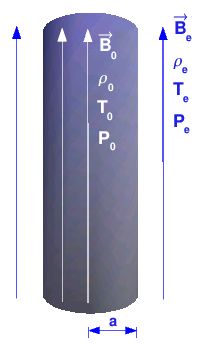Visualisation of linear MHD waves in a coronal loop

|
By Erwin VerwichteThe theory of MHD waves in loops has been modeled by Edwin & Roberts (1983), where the loop is considered to be a straight cylinder with the equilibrium media inside and outside homogeneous. Across the interface, total pressure and radial displacement are continuous. The magnetic field is directed parallel to the cylinder axis. To help understand how the linear MHD wave solutions look like, I have produced images and movies of the density perturbation and velocity, as well as dispersion diagrams for a typical coronal case (normalised w.r.t. internal sound speed):
Dispersion diagrams
|
Spatial structure of the modes
 Transverse structure |
 Longitudinal structure |
The following cuts are taken of the cylinder |
m=0 (sausage)
- slow: Dispersion diagram / Transverse structure / Longitudinal structure: propagating, fundamental standing mode, 2nd harmonic standing mode
- fast (1st branch): Dispersion diagram / Transverse structure / Longitudinal structure: propagating, fundamental standing mode, 2nd harmonic standing mode
- fast (2nd branch): Dispersion diagram / Transverse structure / Longitudinal structure (propagating)
- fast (3rd branch): Dispersion diagram / Transverse structure / Longitudinal structure (propagating)
m=1 (kink)
- slow: Dispersion diagram / Transverse structure / Longitudinal structure: Longitudinal structure (propagating)
- fast (1st branch): Dispersion diagram / Transverse structure / Longitudinal structure: propagating, fundamental standing mode, 2nd harmonic standing mode
- fast (2nd branch): Dispersion diagram / Transverse structure / Longitudinal structure (propagating)
- fast (3rd branch): Dispersion diagram / Transverse structure / Longitudinal structure (propagating)
m=2 (fluting or ballooning)
- slow: Dispersion diagram / Transverse structure / Longitudinal structure (propagating)
- fast (1st branch): Dispersion diagram / Transverse structure / Longitudinal structure (propagating)
- fast (2nd branch): Dispersion diagram / Transverse structure / Longitudinal structure (propagating)
- fast (3rd branch): Dispersion diagram / Transverse structure / Longitudinal structure (propagating)
m=3 (fluting or ballooning)
- slow: Dispersion diagram / Transverse structure / Longitudinal structure (propagating
- fast (1st branch): Dispersion diagram / Transverse structure / Longitudinal structure (propagating)
- fast (2nd branch): Dispersion diagram / Transverse structure / Longitudinal structure (propagating)
m=4 (fluting or ballooning)
- slow: Dispersion diagram / Transverse structure / Longitudinal structure (propagating)
- fast (1st branch): Dispersion diagram / Transverse structure / Longitudinal structure (propagating)
- fast (2nd branch): Dispersion diagram / Transverse structure / Longitudinal structure (propagating)
m=5 (fluting or ballooning)
- slow: Dispersion diagram / Transverse structure / Longitudinal structure (propagating)
- fast (1st branch): Dispersion diagram / Transverse structure / Longitudinal structure (propagating)
- fast (2nd branch): Dispersion diagram / Transverse structure / Longitudinal structure (propagating)

 e /
e /  0 = 0.30,
0 = 0.30, 
